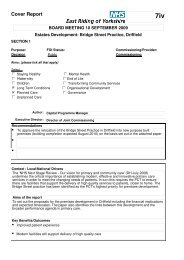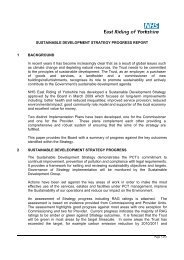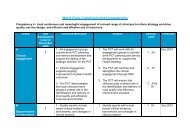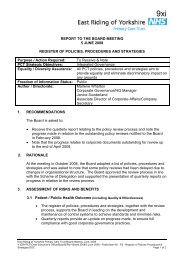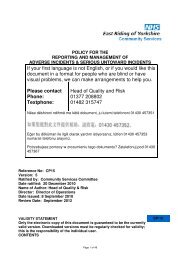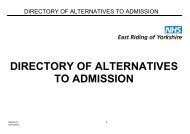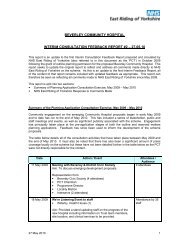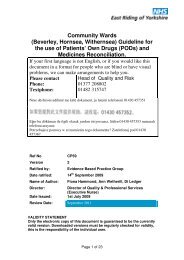Guidelines for the Management of Haematological Malignancies
Guidelines for the Management of Haematological Malignancies
Guidelines for the Management of Haematological Malignancies
You also want an ePaper? Increase the reach of your titles
YUMPU automatically turns print PDFs into web optimized ePapers that Google loves.
11 EXTRANODAL MARGINAL ZONE<br />
LYMPHOMA (MALT–type lymphoma)<br />
Key Issues<br />
• Identification <strong>of</strong> patients who require active treatment with chemo<strong>the</strong>rapy<br />
• Great uncertainty about <strong>the</strong> impact <strong>of</strong> treatments on overall survival<br />
Diagnostic Criteria<br />
Typical Cases<br />
1. Cellular composition includes small lymphocytes, centrocyte-like cells, 'monocytoid' B-cells,<br />
plasmacytoid cells.<br />
2. Invasion <strong>of</strong> epi<strong>the</strong>lial structures and existing germinal centres.<br />
3. CD5 - , CD10 - , CD19 + , CD20 + , CD23 - , sIgM + , sIgD + or - .<br />
4. Disease localized to or centred on an extranodal site.<br />
Assessment <strong>of</strong> residual disease<br />
The definitive diagnosis <strong>of</strong> residual disease requires <strong>the</strong> same criteria as at presentation. Solitary or<br />
multiple B-cell aggregates without germinal centres and cellular morphology suggestive <strong>of</strong> marginal<br />
zone lymphoma should be reported as suspicious and fur<strong>the</strong>r follow up advised. The significance <strong>of</strong><br />
molecular remission remains uncertain.(Bertoni, Conconi et al. 2002)<br />
Trans<strong>for</strong>mation<br />
The criteria are <strong>the</strong> same as <strong>for</strong> follicular lymphoma. The significance <strong>of</strong> increased numbers <strong>of</strong> large<br />
lymphoid cells is uncertain in o<strong>the</strong>rwise typical cases.<br />
Prognostic Factors<br />
Extranodal marginal zone lymphoma with t(11;18)(Streubel, Simonitsch-Klupp et al. 2004) in <strong>the</strong><br />
stomach may be resistant to helicobacter eradication. (Nomura, Yoshino et al. 2003)<br />
Essential Investigations<br />
• Bone aspirate and trephine<br />
• CT scan <strong>of</strong> thorax, abdomen and pelvis<br />
• Serum immunoglobulins<br />
• Direct Antiglobulin Test (DAT)<br />
• LDH<br />
11.1 Gastric Marginal Zone Lymphoma<br />
Primary Treatment<br />
• Patients with Stage IE disease should receive Helicobacter pylori eradication as sole <strong>the</strong>rapy.<br />
(Wo<strong>the</strong>rspoon, Doglioni et al. 1993; Wo<strong>the</strong>rspoon 1998)<br />
• Follow-up with upper GI endoscopy and biopsy every 6 months <strong>for</strong> <strong>the</strong> first 2 years.<br />
• Patients with recurrent disease after 1 year, stage greater than 1E or persistent and<br />
symptomatic disease with visible bulky disease after helicobacter eradication should be<br />
treated with chlorambucil (NCRI trial <strong>of</strong> chlorambucil vs. chlorambucil/ Rituximab<br />
IELSG19/MALT trial is closed now and is on follow up). (Level 1)<br />
• Patients with persistent / recurrent symptomatic disease despite chlormabucil may be treated<br />
with a purine analogue or single agent rituximab.<br />
<strong>Guidelines</strong> <strong>for</strong> <strong>the</strong> <strong>Management</strong> <strong>of</strong> <strong>Haematological</strong> <strong>Malignancies</strong><br />
11. EXTRANODAL MARGINAL ZONE LYMPHOMA<br />
24




